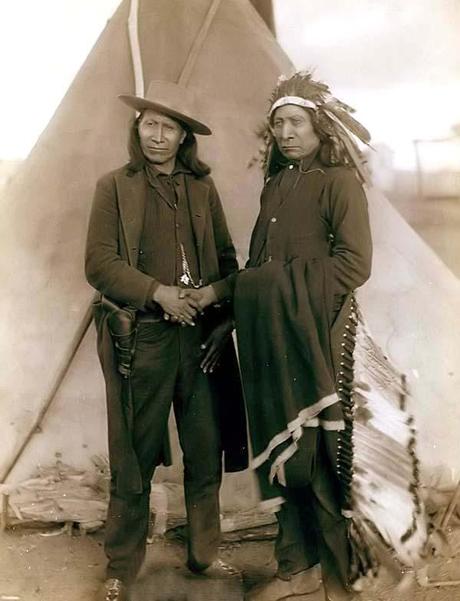
Red Cloud (on right with feather head-dress), chief of the Oglala Lakota Sioux, who defeated the US Cavalry in several encounters 1866-1868 (Red Cloud's War) resulting in the 1868 Treaty of Fort Laramie, that gave the Sioux rights of "absolute and undisturbed use and occupation" of the South Dakota Black Hills and surrounding territories.
It's an old story, retold many times, but never enough for its full importance to sink in.
When Christopher Columbus landed in the Western Hemisphere in 1492, the place was already thriving with tens of millions of native Americas, great civilizations covering continents north, south, and central. Over the next 400 years, waves of Europeans would come and systematically settle the land, dispossessing native people of their traditional homes along the way, often through brutal violence. In no place was this done more forcefully than in the USA, and the final stroke, breaking the last resistance, came at a small creek on the South Dakota Sioux reservation called Wounded Knee.
We remember Wounded Knee today mostly for two events: First is the December 29, 1890, massacre of between 150 and 300 Indian men, women, and children, as the men were being disarmed en route to the reservation -- often portrayed as the final climax of the Plains Indian Wars of the 1800s. Then, three generations later, in 1973, came the second event, a siege mounted by 300 descendants of the original Wounded Knee Indians (calling themselves the American Indian Movement) who, in an attempt to protest decades of poverty, corruption, and broken promises, took up arms and seized the town of Pine Ridge on the Reservation. They held it for 71 days against US marshals, FBI, and military support.
Over the next few weeks, Viral History is proud to bring you a series of posts about Wounded Knee, setting the record straight on this history and updating it to the 21st Century.
- First, we tackle the 1890 Wounded Knee massacre/battle and how it set the stage for things to come;
- Next, we take a close lawyerly look at one of the treaties foisted on the Sioux and never lived up to;
- After that, we are happy to host a Guest Blogger piece from Marshall Matz, who, as a young staff lawyer to US Senator of George McGovern (member of a delegation brought to Wounded Knee to negotiate an end to the 1973 siege), had a unique close-up view of those events that he shares for the first time, and
- Finally, a digression to the famous 1876 battle of Little Bighorn in nearby Montana and a facet that I have always found haunting - the story of Major Marcus Reno, Custer's second in command. Reno survived the battle but came home to accusations of cowardice, two military Court Martial prosecutions, bouts of drinking, a broken marriage, and an early death. Who paid the bigger price? Custer, who "died with his boots on" in Montana? Or Reno, who had to come home and face defeat?
The legacy of Wounded Knee lives on, and with it the responsibility to make things right.
So stay tuned during June as the drama unfolds. Enjoy.

